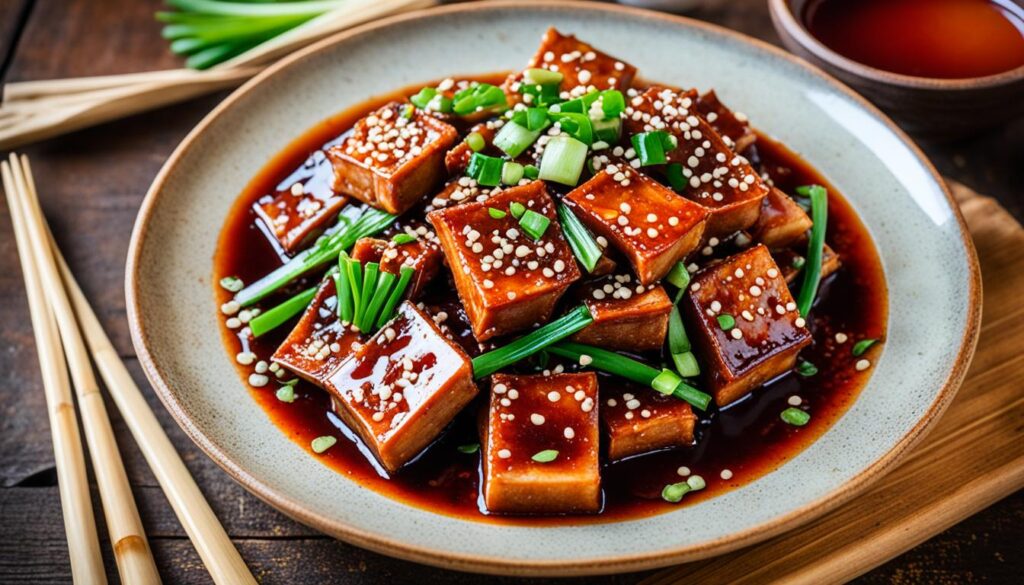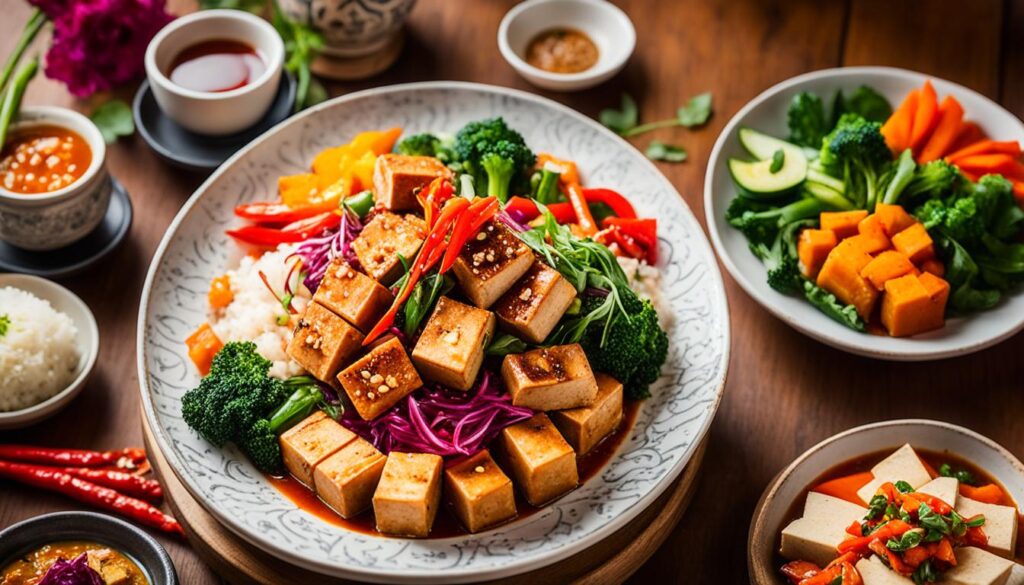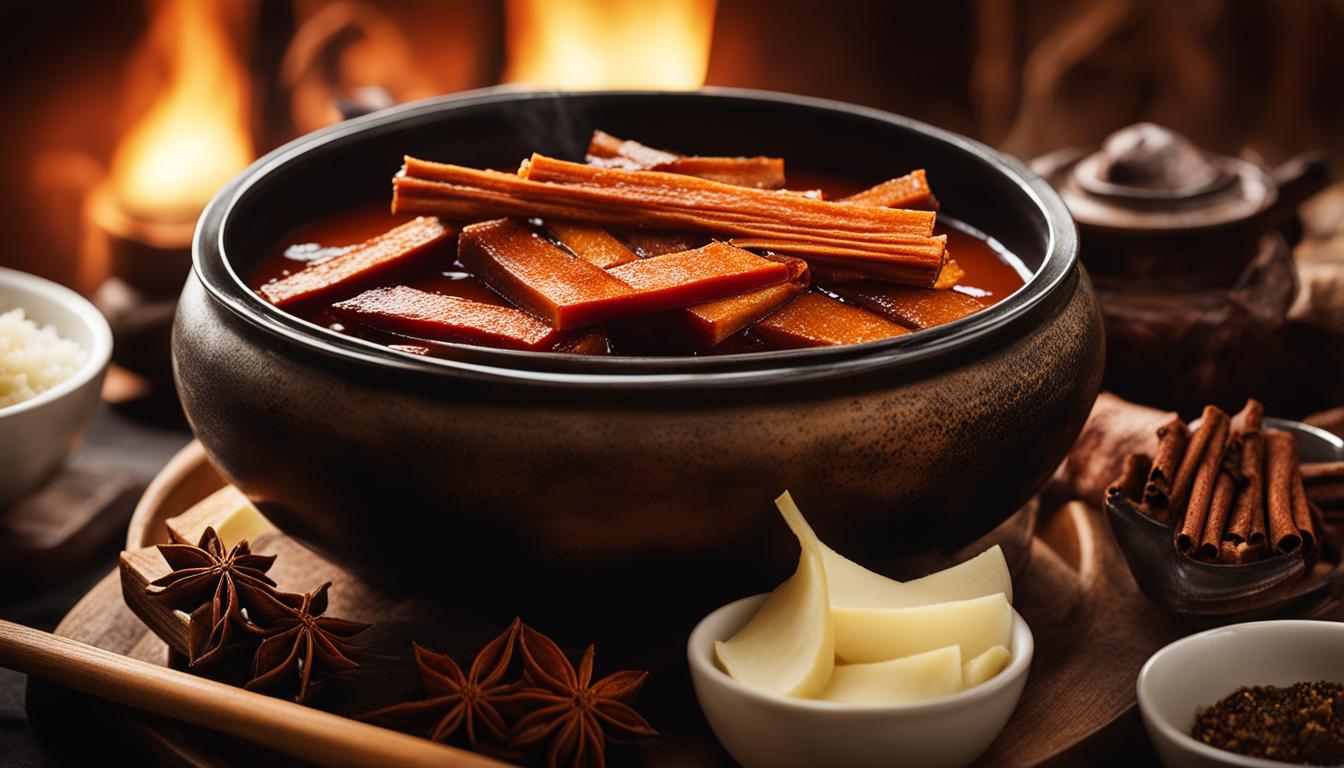Are you ready to discover the hidden potential of tofu skin? This seriously Asian tofu skin red braised dried beancurd sticks recipe will challenge your perception of vegetarian dishes. Grab your apron and get ready for a culinary adventure that will leave your taste buds craving for more.
Tofu skin, also known as yuba, dried beancurd, or soybean skin, is not your average ingredient. It’s a versatile staple in Chinese cuisine that can transform into a mouthwatering delight when prepared with care.
Key Takeaways:
- Discover the incredible flavors and textures of red braised tofu skin
- Learn the essential steps to prepare dried tofu skin for cooking
- Unlock the secrets of an authentic traditional red braised tofu skin recipe
- Explore the variations of Buddha’s Delight, a Chinese vegetarian classic
- Expand your culinary horizons with the versatility of tofu skin
How to Prepare Dried Tofu Skin for Cooking
If you’re ready to embark on a culinary adventure with dried tofu skin, it’s important to know how to prepare it for cooking. The process of rehydrating dried tofu skin involves a simple yet crucial step that ensures the best texture and flavor in your dishes.
To start, you’ll need to gather some high-quality dried beancurd sticks. These can be easily found in Asian markets or specialty grocery stores. Once you have your dried tofu skin, follow these steps to prepare it:
- Soak the dried beancurd sticks in water for at least 6 hours or up to a day. This soaking process rehydrates the tofu skin, making it tender and pliable. Ensure that the water fully covers the tofu skin during soaking.
- Cut the rehydrated tofu skin into chunks of your desired length. This will make it easier to handle and cook in your chosen recipe.
- Cook the tofu skin chunks in a flavorful braising liquid. Whether you’re making a red braised tofu skin dish or any other recipe, the pre-soaked tofu skin is ready to absorb all the delicious flavors.
In addition to using store-bought dried tofu skin, you can also make homemade beancurd sticks by lifting away the sheet that forms on the surface of heated soy milk and drying it. This process gives you the option to create customized tofu skin shapes and sizes for your dishes.
Discover the beauty of rehydrating dried tofu skin with our tofu skin cooking tips and unleash your culinary creativity in the kitchen.
A Traditional Red Braised Tofu Skin Recipe
This traditional red braised tofu skin recipe is a delicious and satisfying vegetarian dish. To make this recipe, you will need half a package of dried beancurd sticks, soy sauce, sugar, rice wine, ginger, star anise, cinnamon, and optional dried red chilies. The dried beancurd sticks should be soaked in water for at least 6 hours before cutting them into chunks and cooking them in a pot with the rest of the ingredients. The sticks are simmered in stock or water until tender and flavorful. This red braised tofu skin dish is perfect for serving with steamed rice or noodles.

Ingredients:
- 1/2 package of dried beancurd sticks
- 2 tablespoons soy sauce
- 2 tablespoons sugar
- 2 tablespoons rice wine
- 1 teaspoon grated ginger
- 2 star anise
- 1 cinnamon stick
- Optional: dried red chilies for heat
Instructions:
- Soak the dried beancurd sticks in water for at least 6 hours or overnight until softened.
- Drain the beancurd sticks and cut them into 2-inch chunks.
- In a pot, combine the soy sauce, sugar, rice wine, grated ginger, star anise, cinnamon stick, and dried red chilies (if using).
- Add the beancurd sticks to the pot and pour in enough stock or water to cover them.
- Bring the liquid to a boil, then reduce the heat and simmer for about 30 minutes or until the beancurd sticks are tender.
- Remove the star anise, cinnamon stick, and dried red chilies (if used) before serving.
This red braised tofu skin recipe is a classic Asian dish that combines the tender texture of the beancurd sticks with a rich and savory braising liquid. The combination of soy sauce, rice wine, and aromatic spices creates a flavorful base for the tofu skin to absorb. The result is a mouthwatering vegetarian dish that can be enjoyed on its own or paired with rice or noodles for a satisfying meal.
Variations of Buddha’s Delight (Luo Han Zhai)
Buddha’s Delight, also known as Luo Han Zhai, is a popular vegetarian dish that is often enjoyed during Chinese New Year celebrations. This dish has a long-standing tradition and is commonly consumed by Buddhist monks. One of the key features of Buddha’s Delight is its versatility, as it can be prepared in various ways, allowing for different combinations of vegetables, tofu, and other ingredients.
The basic ingredients of Buddha’s Delight include napa cabbage, mushrooms, wood ears, lily flowers, fried tofu puffs, and bean threads. These ingredients come together to create a flavorful and nutritious dish that is loved by many. However, the beauty of Buddha’s Delight lies in its ability to be customized and adapted to personal preferences.
While the aforementioned ingredients are commonly used, there are other vegetables that can be added to enhance the flavors and textures of the dish. Some popular additions include leeks, snow peas, bean sprouts, carrots, and baby corn. By incorporating these additional vegetables, you can create your own unique variation of Buddha’s Delight.
Each variation of Buddha’s Delight offers a different culinary experience, with a delightful combination of flavors and textures. Whether you prefer a milder, subtly seasoned dish or a bolder, spicier version, you can adjust the ingredients and seasonings to suit your taste.
Sample Variation: Spicy Buddha’s Delight
If you enjoy bold and spicy flavors, you can create a spicy variation of Buddha’s Delight. In addition to the basic ingredients, you can add dried red chilies or chili flakes to give the dish a kick. The spiciness can be adjusted according to your preference, making this a perfect variation for those who appreciate heat in their meals.
Sample Variation: Mushroom Lover’s Buddha’s Delight
For mushroom enthusiasts, you can create a mushroom-focused variation of Buddha’s Delight. In addition to the basic ingredients, you can incorporate different types of mushrooms such as shiitake, oyster, or enoki mushrooms. The earthy and umami flavors of the mushrooms add depth and richness to the dish, making it a treat for mushroom lovers.
With its rich history and adaptability, Buddha’s Delight continues to be a beloved Chinese New Year dish and a staple in Chinese vegetarian cuisine. Whether you choose to stick to the traditional recipe or explore different variations, this flavorful vegetarian dish is sure to satisfy both your taste buds and your soul.

Conclusion
The seriously Asian tofu skin red braised dried beancurd sticks recipe is a delightful and flavorful dish that highlights the versatility of tofu skin in Chinese cuisine. By pre-soaking the dried beancurd sticks, they become tender and perfectly absorb the rich flavors of the braising liquid, resulting in a juicy and satisfying vegetarian option. Whether you’re a tofu enthusiast or looking to explore authentic Asian recipes, this dish is a must-try.
Furthermore, the variations of Buddha’s Delight offer a wide range of combinations with different vegetables and ingredients, making it a customizable and versatile dish in Chinese vegetarian cuisine. With its diverse flavors and textures, Buddha’s Delight is ideal for both special occasions and everyday meals. The options for personalization and creativity are endless.
Whether you’re seeking an authentic red braised tofu skin recipe or interested in experimenting with variations of Buddha’s Delight, these dishes are sure to impress both vegetarians and non-vegetarians alike. The seriously Asian tofu skin recipe and the traditional red braised tofu dishes embody the essence of Asian flavors and showcase the true potential of tofu skin as a star ingredient. So, why not indulge in the richness of these authentic Asian dishes and embark on a culinary journey to satisfy your taste buds?
